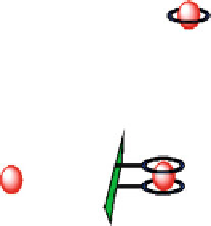Biomedical Engineering Reference
In-Depth Information
a
b
0.7
0.8 0.9
1.0
1.1
0.7
0.9
1.1
VM
VM
Fig. 10 CVs of (a) a 2.0 mM 9 solution in 0.10 M Bu
4
NPF
6
/MeCN; (b) 9 + four times excess of
Zn
2+
. Potential scan rate of 100 mV/s
K
N
L2 · Cd (NO
3
)
2
R
N
n
O
N
10
R=Me,n=1
11
R=H,n=1
12
R=Me,n=2
N
O
n
N
+
R
K
N
L6 · Zn (NO
3
)
2
L6 · Cd (NO
3
)
2
Scheme 3 Possible complex formed by ligands 10-12
in energetic terms to be accompanied by amidic hydrogen removal. For this very
reason, when no base is present in the medium, it interacts with Zn
2+
in the same
way as ligand 10 does, resulting in 80% quenching. When an excess of base
(tetrabutylammonium hydroxide) is added, amidic hydrogen is removed and, in
this situation, Zn
2+
is chelated by both nitrogens of the same branch (Fig.
11b
). This
disposition does not constrain the torsion angle between the aromatic biphenyl rings
and quenching is not induced.









































Search WWH ::

Custom Search